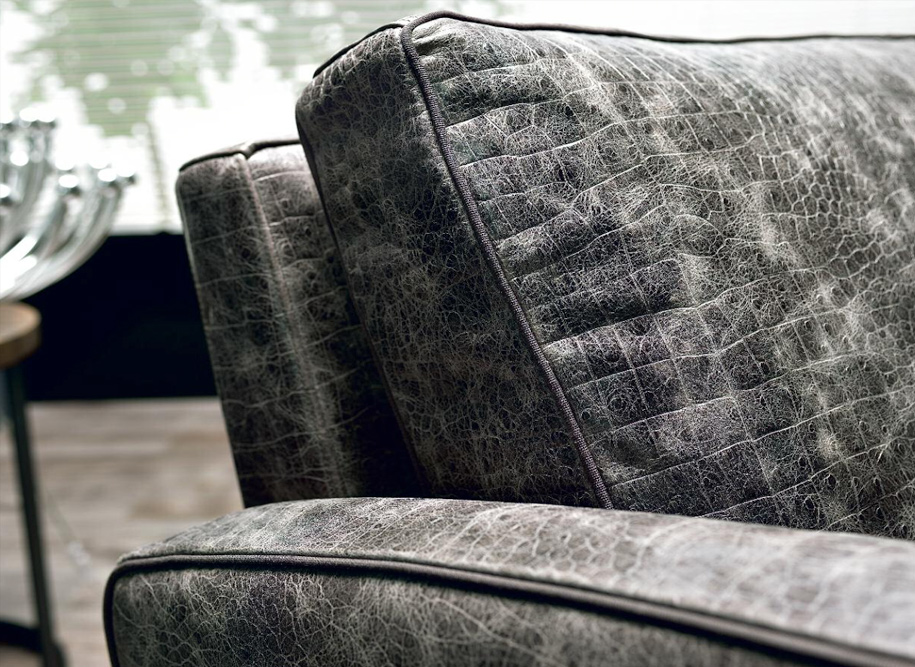1 - What is "PIENO FIORE"
They are defined as “pieno fiore” that leathers which, for their natural beauty, do not need any superficial treatment of additional touch concerning the coat. Therefore these leathers have a natural look, they distinguish themselves by the open pores (visible with a lens), by the differences of grain and by the signs, which emphisize their beauty and certify their naturality. The adventages of “pieno fiore” are numerous: above all the capacity of improving with age, a greater elasticity which allows a complex manufacturing making, and that is to say a way superior aesthetic result. Cava has chosen to work exclusively with this specific and very prestigious kind of hides.
2 - HISTORY of the tanning techniques
In order to explain the discovery of the possibility of tanning leathers we suppose that, casually, someone of our ancestors threw some skinned hides into some sort of pond or pool of water, and he eventually found them still undamaged days later. Obviously this fact finds a scientific match, in fact, into a pond or a pool of water, it is likely to create a particular situation so that there is a higher quantity of natural tannins (tannin is a tanning substance) coming from the decomposition process of the leaves which have fallen into the water. In the history man has succeeded in reefing his ability of tanner, as it is shown in the bible, until the middle age, period during which “the art of tanning hide” was born. Between 1700 and 1800 the first centres for tanning start to appear in Arzignano’s country. This is due to the position of the city itself, which was situated in the high valley of Chiampo ( a river that passes trough Arzignano and takes its name from a near village) and for this reason it creates a rapid movement which allowed the watermills to work and eventually grind the tanning materials.
3. PROVENANCE of raw hides
The leathers used for furniture are bovine. They can come from Europe or from outside Europe (people who work with these products use to call them “exotic”, meaning that they come from Australia or South-America). Exotic leathers: warmer weather and full of parassities originates more damaged and dry leathers, that happens because animals are bred outside. European leathers: these leathers come from boves bred in a shed and feed with pasture so that the leathers result much more smooth and cleaned. Furthermore a medium size allows more complex makings with less waste.
4. REVIVING
The raw material goes trough a washing with a great amount of water which eliminates impurities. Eventually leathers go under a special press which takes away all the excessing water and it stretches the mantle.
5. The SPLIT
The unprocessed leathers are divided by two. The external part, the most precious and smooth part, it is called “fiore”(flower). While the part below is called “crust”, it is less close and resistant, it is intended for economical products.
6. SELECTION
The “flowers” obtained by dividing parts undergo a very scrupulous selection: only the best leathers (an average of 10%) are then classified as “PIENO FIORE” (full flowers) and they go directly through the phase of tanning without any additional touch/superficial treatment. Another 30% of the less precious leathers undergoes a treatment of selective “sandpapering”/ “emery rubbing”, an abrasion of the more damaged parts. Depending on the intensity of the treatment, they are eventually classified as “half-a-flower” or “retouched flower”. The remaining 60% has a high defectiveness. Leathers undergo the “sandpapering” process for all the surface. These leathers are called “emery flowers” and they are recognizable for their uniformity on the whole surface.
7. DYEING
The process of tanning and dyeing precious leathers takes place in apposite drums so that the dye can penetrate the whole section. On the contrary, economical leathers are dyed by spraying the surface, in this way any scratch might reveal the lighter leather’s undercoating (they are recognizable for the difference between the surface and the section below) . For the more valuable articles Cava has chosen to use the process of tanning using drums and dyes made up with aniline. Leathers made with there colouring have a natural look and they have no pigment on the surface, and when the process is completed, it follows the application of a very light protection based on wax, which softens the leathers and allows it to breath.
8. Finishing
The last phase of this complicate working process, , the that could be said the “maquillage’s phase”, the final touch of the tanner artist. Cava has chosen a slight protection, obtained by a transparent finishing which gives the product a very natural aspect; on the contrary a covering finishing would protect the leather but it would compromise its natural smooth.
9. MAINTEINANCE AND CLEANING
It is recommended that you keep these products at least 30cm from any source of heat and that you protect them form direct sun’s light. As regards cleaning, any kind of stain must be removed as soon as possible: cleaning it in a good time it is essential in order to obtain a good result. Any commercial stain remover should not be used because these products and the transparent protection of the leather could be incompatible. It is suggested that you keep it clean with a dry cotton flock without rubbing. If this doesn’t work, you could wet a cotton flock and make a circular movement on the stain, always without rubbing. In case of scratches or slight signs, the “flower” can be restored by rubbing it with a woollen cloth, a very simple gesture which it will allow the darker oils to reach the surface and correct imperfections.
